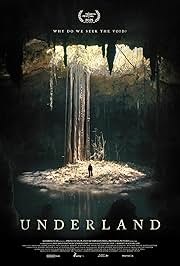Eye For Film >> Movies >> Underland (2025) Film Review
Underland
Reviewed by: Amber Wilkinson

Man’s connection and fascination with what lies beneath our feet is ancient. Myths about underworlds span across cultures and religions and, to this day, the underground is a place that is open for exploitation, exploration, reverence or dread. Rob Petit’s visually arresting documentary – based on Robert Macfarlane’s bestseller of the same name – takes us into some of these spaces with a handful of people who know them the best.
A chorus of expert voices is framed by philosophical interjections from Macfarlane’s book, narrated by German A-lister Sandra Hüller. With its heavyweight producers including Darren Aronofsky and Lauren Greenwood, it’s highly likely to be coming to a cinema near you at some point. While the brevity of the running time means that it doesn’t always dig as deeply as it might, this is nevertheless a polished and beguiling piece of cinema that invites us to forge our own associations between different epochs and beliefs.
A trio with very different experiences of life underground are our chief guides. In Cenote in the northern part of the Yucatan peninsula, archeologist Fátima Tec Pool is cave diving with her team in search of traces of Mayan art. Thousands of miles away in the storm drains beneath Las Vegas and elsewhere, urban explorer and writer Bradley Garrett is also considering mankind’s traces and subterranean artwork. Finally, theoretical physicist Mariangela Lisanti is working in the SNOLAB research facility in Canada. Sunk deep in the earth, she is on the hunt for dark matter or, as she puts it rather more poetically, trying to work out how to “catch a ghost”.
Elegant editing from David G Hill, Anna Price, Andy R Worboys and Julian Quantrill helps the transition between the environments feel like a flow rather than a chop and change. Thought has also gone into the presentation of the film in different chapters, including The Forbidden Tomb and The Sacred Chamber, so that the experts’ thoughts are also cohesive even when coming at notions from radically different angles.
Beyond the visuals, Petit attempts to engage other senses right from the start. Tec Pool talks about the sound being the first thing that hits her when she steps into a cavern, as we hear the birds that make the upper gallery their home, while Garrett offers an evocative description of the smells – “of freedom” – he associates with the storm drains. Lisanti’s working world, meanwhile, is defined by absence – of dust, of sound and, as we learn, concrete evidence of the dark matter she is seeking. Other filmmakers have made similar journeys before, most notably Spanish director Victor Moreno with his subterranean dive beneath Madrid, The Hidden City, but Petit and Macfarlane’s nudge towards the more overtly philosophical makes this a distinctive addition to the genre.
Melancholy about the fact we are leaving nuclear waste rather than handprints for our descendants to find mixes with more hopeful ruminations on our intent to care for those who come after us. Hannah Peel’s score also varies with the territory, sometimes percussive, at others more industrial, while Ruben Woodin Dechamps’ camerawork has an attention to detail that gives a sense of tuning into each space’s secrets. As our trio of explorers make their ascents, it’s likely your thoughts will remain with what you’ve seen beneath the ground, although thanks to this Petit, you won’t feel in the dark.
Reviewed on: 10 Jun 2025

















